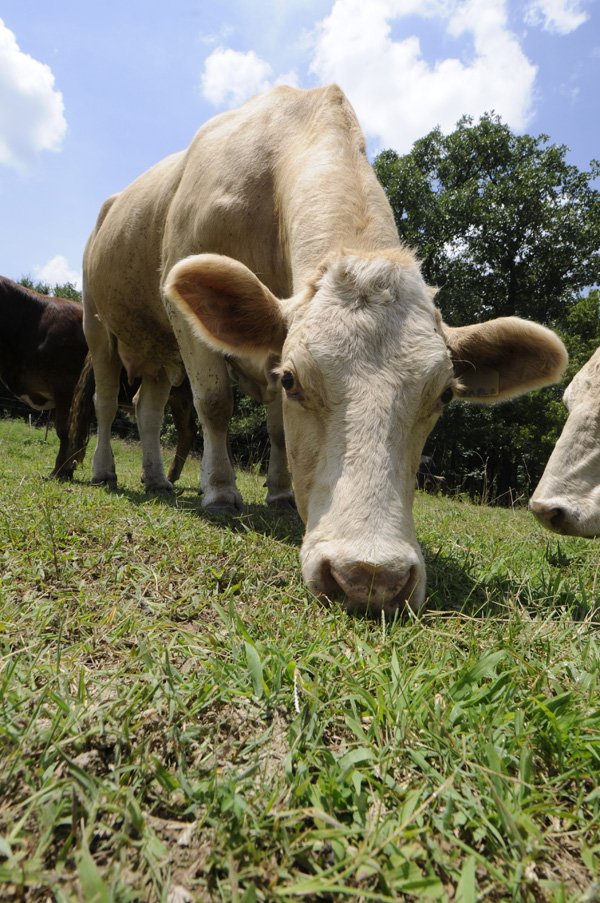NORTHWEST ARKANSAS — What happens when bison are crossed with beef cattle of any breed - beefalo of course.
Hybrid beefalo is growing in popularity because of consumer demand for leaner meat and it’s a cheaper alternative to bison meat, said Larry Hacker, who’s been raising the animals for more than two decades.
Hacker runs a beefalo breeding operation on the Done Rovin’ Beefalo Farm about two miles southwest of Lincoln. He and wife Nelda settled there after a 28-year military career that included a term in Vietnam and seven years in Europe.
With about 60 cow-calf pairs, Hacker’s registered beefalo herd is having a hard time keeping up with the orders he gets for both breeding stock and processed beefalo meat.
“I have one 19-year-old cow that I would like to retire, but it’s been hard to retain any heifers the last few years because buyers are calling me from all over the country wanting breeding stock.” Hacker said.
Hacker sold two heifers and a bull earlier this week to a longtime customer in Texas. He said three months ago he sold a 21-year-old beefalo cow to a family who wanted a specific bloodline no longer available.
“We had twin calves last season and one had a broken leg. We set the break and put a makeshift cast on the baby and the leg healed fine. We sold it as breeding stock because a family wanted it despite the injury,” Nelda Hacker said.
Beefalo are precisely 37.5 percent buffalo and 62.5 percent domestic beef cow.
The hybrids have been selected to take advantage of the best traits of both its bovine and bison ancestors, according to the breeder.
Hacker’s herd grazes on the ranch’s 120-acre pastureland throughout the growing season and eats hay in the winter with an occasional range cube treat.
“I go out every morning and brush the cows by hand to keep the herd comfortable with human contact. They are a docile group compared to their bison ancestors who survived for hundreds of years without care from herdsman or veterinarians,” Hacker said.
The herd, while almost 38 percent buffalo, looks like a typical mix of black Angus, white Charlois and brown Hereford.
Hacker said the calf’s coat color is always a mystery despite the color of its parents, because the bison genetics scramble the code somewhat.
“Just because you breed a black bull to a black cow doesn’t mean it will yield a black calf.
In fact, it probably won’t happen the first time,” Hacker said.
“Consequently, I have breeding stock in every color and that works out well because buyers in different parts of the country prefer certain colors.”
Black is preferred in the Midwest. White or gray is wanted in the North, while red cows are preferred east of the Mississippi River, Hacker adds.
The American Beefalo Association said some 250 registered farms across the country and about a dozen farms in Arkansas raise hybrid beefalo.
Many got their start from Hacker’s breeding stock, said Johnny Gunnsaulis, extension agent for Washington County Cooperative.
Lean Meat
Hacker culls his herd when the calves are roughly seven monthsold and again at one year.
Yearlings not kept for breeding stock are sold on the hoof for processing into beefalo meat.
“I just have one steer left for processing until next year because of the strong demand,” Hacker said. “I could sell more if I had them.”
One meat customer from Little Rock buys a half-side each year to reduce his cholesterol consumption, Hacker said.
The U.S. Department of Agriculture approved beefalo meat for public sale in 1985.
Hacker said the leaner meat has nearly one-fi fth the fat and one-third the calories of traditional beef.
The beefalo trade association confi rmed the meat is a lean protein source with the cholesterol levels comparable to cod as noted in the reports compiled by the USDA.
One-quarter side of beefalo processed at Garner Meats in Van Buren costs about $3.20 per pound, whether it’s steak or ground hamburger.
Richard McGinnis, owner of Richard’s Country Meat Market in Fayetteville, was selling ground bison meat for $6.99 per pound last week.
McGinnis said bison ribeye steaks generally cost about $15 a pound, when he gets them from a farm in Marshall.
This compares to beef hamburger costs of $3 per pound and steak prices starting at $10 per pound at other local grocery stores.
As the commercial beef herd continues to shrink, analyst say the herd will reach its lowest level in 59 years when the USDA reports in January, which means there will be less beefavailable for consumption.
Kay said per-capita consumption is expected to decrease by nearly 3 pounds between 2009 and 2011 because there is less beef available at prices that cashstrapped consumers fi nd too expensive.
Hacker would love to see beefalo meat help fill that protein hole, but he’s already selling all the meat he has available each year.
“It’s a good problem to have,” he said with a grin.
Business, Pages 21 on 07/25/2010

